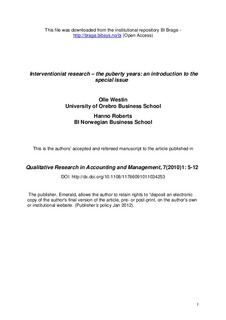Interventionist research – the puberty years: an introduction to the special issue
Journal article, Peer reviewed
Permanent lenke
http://hdl.handle.net/11250/93922Utgivelsesdato
2010Metadata
Vis full innførselSamlinger
- Scientific articles [2181]
Originalversjon
10.1108/11766091011034253Sammendrag
Purpose: To provide an introduction and overview of the various papers in this Special Issue.
Design/methodology/approach: A short discussion of the main quests of interventionist research and how these are related to the papers in this Special Issue.
Findings: The essence of interventionist research is its methodological location, researching where practice and theory meet.
Research limitations/implications: Interventionist research places strong demands on the individual researcher’s interpretative, social, and abstracting skills in order to carry observations to ontological and epistemological levels.
Practical implications: Interventionist research is rich in research designs and specific intervention types. Selecting the “right” one is strongly related to the connection the researcher makes with the social context (s)he will operate in. Changes over time in both design and intervention can be expected, given the dynamic, longitudinal and interactive nature of interventionist research.
Originality/value: This Special Issue provides examples of a varied set of interventionist research situations, including the selection of typical intervention methods and how knowledge contributions were extracted
Beskrivelse
This is the authors’ accepted and refereed manuscript to the article
